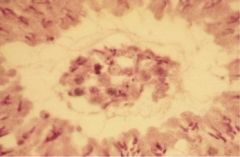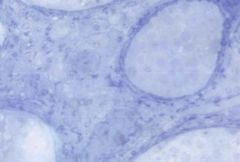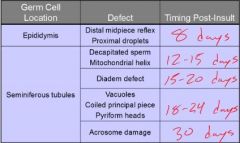![]()
![]()
![]()
Use LEFT and RIGHT arrow keys to navigate between flashcards;
Use UP and DOWN arrow keys to flip the card;
H to show hint;
A reads text to speech;
63 Cards in this Set
- Front
- Back
|
Spermatozoa
-produced where |
-seminiferous tubules of the testes
|
|
|
Spermatogenesis
-involves |
-proliferation of stem cells
-meiotic division of stem cells -differentiation from a nucleated round cell to a more specialized tadpole shape |
|
|
Spermatogenesis
-importance of meiosis |
-homologous chromosomes form pairs and exchange DNA --> every chromosome in a sperm cell has DNA from sire and Dam
|
|
|
Sperm
-levels of development |
Spermatogonium --> (mitosis) additional spermatogonia
-primary spermatocyte -(1st mieotic division) secondary spermatocye -(2nd mieotic division) spermatids -sperm |
|
|
Sperm
-reduction divisions in formation begin when |
-puberty
|
|
|
Onset of meiosis is controlled by:
|
-mieosis inducing substance (MIS)
-meiosis preventing substance (MPS) *secreted by testicular tissue |
|
|
Sperm
-plasma membrane function |
-micro-domains of signaling molecules
|
|
|
Sperm
-head importance |
-contains chromatin
-posterior portion attach to the egg -acrosome |
|
|
Sperm
-acrosome importance |
-membrane enclosed sac of enzymes important for penetrating the Zona pellucida of the oocyte
|
|
|
Sperm
-mitochondria importance |
-convert glucose to ATP
-located in midpiece |
|
|
Sperm
-tail importance |
-necessary to swim to oocyte, penetrate zona pellucida, fertilize egg
|
|
|
Sperm
-tail parts |
-midpiece
-principle piece -end piece |
|
|
Testicle
-main component |
Tightly packed seminiferous tubules
-90% (bulls, rams, rats) -60% (boars, stallions) |
|
|
Sertoli cell
-function |
-support maturation of spermatogonia
|
|
|
Testicle
-interstitial tissue components |
-blood vessels
-nerves -leydig cells |
|
|
Leydig cells
-main function |
-synthesize steroid hormones (testosterone)
|
|
|
Sperm
-proximal droplet is a representation of? |
-old cytoplasm
|
|
|
Sperm
-travel |
-seminiferous tubules
--rete testis ---efferent ducts ----epididymis -----vas deferens |
|
|
Rete testis
-define |
-collection from seminiferous tubules
-located in center of testicle |
|
|
Efferent ducts
-define |
-3-20 ducts leading from rete testis to epididymis
|
|
|
Epididymis
-define |
-single long tubule that is metabolically active
-tail stores sperm |
|
|
Vas deferens
-function |
-connects epididymis to urethra
-has thick muscular wall for ejaculation |
|
|
Spermatozoa
-movement when taken from rete testis |
-weak vibrating movement of tail
|
|
|
Spermatozoa
-movement when taken from head of epidiymis |
-slow circular motion
|
|
|
Spermatozoa
-movement when taken from the tail of the epididymis |
-vigorous uni-directional progressive motility with longitudinal rotation of the head
|
|
|
Physiologic changes in spermatozoa as they traverse the tubular tract
|
-gain ability for progressive motility
-acrosome matures -plasma membrane stiffens in some areas and increases flexibility in others |
|
|
The ability of the epidiymis to maintain sperm viability and allow maturation is dependent on?
|
Androgen steroids
-testosterone |
|
|
Blood-Testis Barrier
-define |
-tight junction between sertoli cells which divide tubules into 2 compartments
|
|
|
Blood-Testis Barrier
-compartments |
-Basal Compartment
-Adluminal compartment |
|
|
Blood-Testis Barrier
-Basal compartment function |
-contains spermatogonium and preleptotene spermatocytes
|
|
|
Blood-Testis Barrier
-Adluminal compartment function |
-communication with lumen of tubule and contains more advanced stages
|
|
|
Blood-Testis Barrier
-permeability |
-complete exclusion of antibody
-free transfer of androgen-binding protein and inhibin |
|
|
Blood-Testis Barrier
-function |
Keeps haploid cells from initiating an immune reaction
-prevents protein hormones and antibodies from coming into contact with germ cells from spermatocytes onward -prevents haploid spermatogenic cell proteins from causing an immune reaction |
|
|
Animal scrotum types:
-without scrotum -intra-abdominal testes -non-pendulous scrotum -pendulous scrotum |
Without scrotum
-reptiles, birds Intra-abdominal testes -elephants, dolphins, whales, armadillos, ... Non-pendulous scrotum -pigs, horses, cats Pendulous scrotum -cattle, sheep, primates |
|
|
Testicle temperature within scortum compared to body temp
|
4-7C cooler
|
|
|
Rise in testicle temperature
-effect |
-abnormal spermatogenesis ---> infertility
|
|
|
Tunica dartos
-define |
-smooth muscle located just below the skin surface of the scrotum
|
|
|
Tunica dartos
-function |
Helps to regulate testicular temperature
-Contraction: reduces surface area available for heat loss -Relaxation: increases surface area available for heat loss |
|
|
Cremaster muscle
-function |
Retracts the testicles
-conservation of heat on a cold day -fight or flight response to move the testicles out of the way |
|
|
Pampiniform plexus
-define |
-coiling testicular artery and vein that creates a counter-current exchange to cool blood in the artery supplying the testicles
-decreases temp of arriving blood by 5C |
|
|
Pampiniform plexus
-effect of fat deposition in the area |
-more insulation ---> decreased heat loss
|
|
|
Puberty
-onset controlled by |
-maturing of the hypothalamic-pituitary-gonadal (leydig & sertoli cell) axis
|
|
|
Puberty in the Bull
-definition |
-ejaculate has a minimum of 50 million total sperm with 10% progressive motility
*not considered sexually mature though |
|
|
Why do sperm cells near puberty have many of the same defects as sperm cells from degenerating testicles?
|
-low testosterone
|
|
|
Disturbances of spermatogenesis are manifested by:
|
-reduced sperm production
-increased sperm abnormalities *Usually # of sperm not counted. Typically if sperm are abnormal it is thought that there is probably an abnormal amount |
|
|
Testicular degeneration
-types |
-Temporary followed by regeneration
or -Permanent followed by fibrosis |
|

Describe
|
Sertoli cells in seminiferous tubules
-only thing that should be found in lumen is tadpole-like sperm -palpate many times as soft |
|
|
One way to know there is a problem with the testicles
|
-ability to make a dent in them with slight pressure
|
|

Describe
|
-seminiferous tubule breakdown with fibrosis
|
|
|
Pathogenesis of abnormal sperm production
|
Anything that drops testosterone levels
-Stress (pain, hunger, cold) -Heat (obesity, scrotal abnormality, climate, fever) -Season (photoperiod, nutrition, temp) -Heredity (sperm defects, testis size) -Puberty (resembles disturbed spermatogenesis) -Toxicity (plant, bacterial, environmental) -Nutritional (protein, Vit A, Se-deficiency) |
|
|
How to know if a defect in sperm production may be hereditary
|
-if hereditary all sperm from different areas of the tract will likely have the same defect
-if non-hereditary sperm defect will correspond to where sperm were in development along the tract when the insult occured |
|
|
How does stress effect sperm production.maturation?
|
-suppresses LH release which is necessary for testosterone production
--testosterone is needed for spermatogenesis and epididymal function *LH is needed to convert cholesterol to testosterone in the leydig cells |
|
|
Subfertility due to increased body temp
-can be caused by |
-excess fat in the scrotum
-high temperature & high humidity -fever |
|
|
Effect of heat on spermatogenesis
|
-testes normally function on the bring of hypoxia
--increase in temp causes a decrease in the metabolic rate ---no corresponding increase in blood flow to the increase in metabolism ----tissue becomes hypoxic |
|
|
Effect of an increase in temperature (fever) on fertility
|
-developing sperm are killed but the sperm already formed are OK for 1-2 wks
-poor quality sperm for at least 1 month -gradual improvement until normal sperm in 3 months |
|
|
Sperm defects correlated to timing of ejaculation post-insult
|

|
|
|
Defects post insult
-8 days post |
-distal midpiece reflex
-proximal droplets *epididymis |
|
|
Defects post insult
-12-15 days |
-decapitated sperm
-mitochondrial helix |
|
|
Defects post insult
-15-20 days |
-diadem defect
|
|
|
Defects post insult
-18-24 days |
-vacuoles
-coiled principle piece -pyriform plexus |
|
|
Defect post insult
-30 days |
-acrosome damage
|
|
|
Sperm
-length of time to mature in seminiferous tubules |
-39 days
|
|
|
Sperm
-length of time to traverse epididymis |
-7-16 days
|

